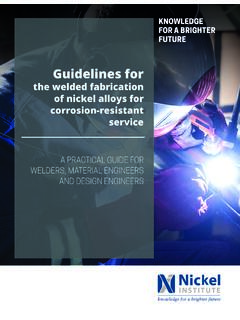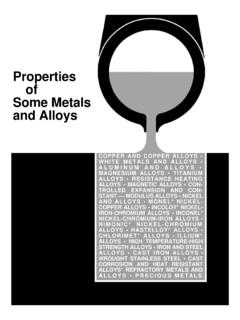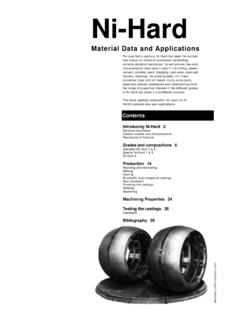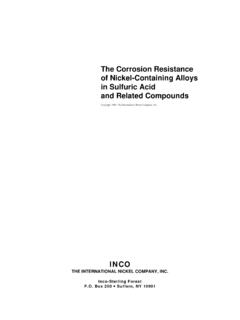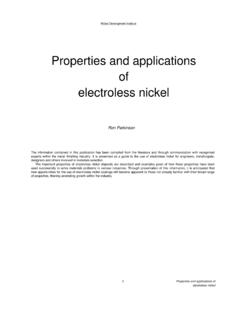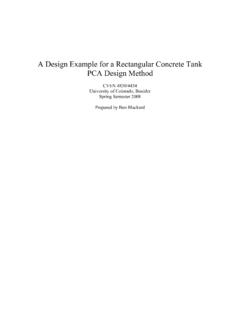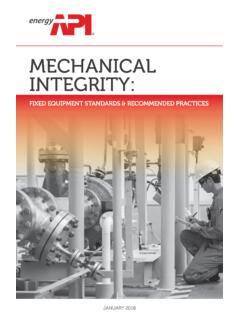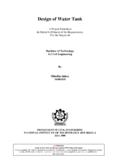Transcription of NICKEL PLATING HANDBOOK - Nickel Institute
1 NICKEL PLATING HANDBOOK2014 ABOUT THE NICKEL INSTITUTEN ickel Institute (NI) is the global association of the world's primary NICKEL producers who together account for approximately 85% of worldwide annual NICKEL production outside China. Our mission is to promote and support the use of NICKEL in appropriate applications. NI grows and supports markets for new and existing NICKEL applications including stainless steel; and promotes science, risk management and socio-economic benefit as the basis for public policy and regulation. Through our science division NiPERA ( ), we also undertake leading edge scientific research relevant to human health and the environment. NI is the centre of excellence for information on NICKEL and NICKEL -containing products and has offices in Asia, Europe and North IN THIS HANDBOOKT erms used in this publication relate to industry practice and are commonly understood by PLATING professionals.
2 The term decorative PLATING is used to describe practices, processes and outcomes for a broad range of applications, but the term decorative often masks the critical nature of the outcome required. Decorative PLATING processes often impart the technical and functional success of the products they are used on. Corrosion resistance, brightness and levelling, mechanical and physical properties are characteristics of these processes and cannot be discounted as cosmetic. 2013 NICKEL Institute . All rights reserved. This HANDBOOK may be reproduced, stored in a retrieval system or archive, or transmitted, in any manner or media now known or later devised, only with appropriate attribution to the NICKEL Institute or the prior written consent of the NICKEL The material presented in the HANDBOOK has been prepared for the general information of the reader, using the data available to us and the scientific and legal standards known to us at the time of its publication.
3 It should not be used or relied upon for any specific purpose or application without first securing competent professional advice. The NICKEL Institute , its members, staff and consultants make no representation or warranty as to this HANDBOOK 's accuracy, completeness, or suitability for any general or specific use and assume no liability or responsibility of any kind in connection with the information presented in it, including but not limited to any deviations, errors or omissions. Reference to this HANDBOOK to any specific commercial product, process or service by trade name, trade mark, manufacturer, or otherwise does not necessarily constitute or imply its endorsement or recommendation by the NICKEL Introduction ..5 2. Understanding the Electroplating Process ..6 Basic Process of Electrodeposition ..6 Rate of Deposition ..7 Current Efficiency ..8 Average Coating Thickness.
4 8 Deposit Thickness Distribution ..10 Current Distribution ..10 Throwing Power ..11 Internal Stress ..11 Levelling and Microthrowing Power ..12 3. Chemistry of NICKEL Electroplating Solutions ..13 The Watts NICKEL PLATING Solution ..13 Function of Ingredients ..13 The Role of Addition Agents ..14 Bright NICKEL PLATING ..14 Auxiliary Brighteners ..15 Anti-Pitting Agents ..15 Semi-Bright NICKEL Solutions ..15 Sulphamate NICKEL Electroplating Solutions ..15 Other NICKEL Electroplating Processes ..164. Anodes for NICKEL PLATING ..17 NICKEL Anode Requirements ..17 Types of NICKEL Anode Material ..18 Titanium Anode Baskets ..19 Power Consumption ..20 Packing Density ..21 Anode Fines ..21 Anode Bags ..21 Practical Tips for Maintenance of NICKEL Anode Baskets ..22 Anode Maintenance - Best Practice ..23 Insoluble Anodes ..23 5. Decorative NICKEL PLATING ..25 Bright NICKEL PLATING .
5 25 Satin NICKEL NICKEL -Chromium Coatings for Exterior Service ..26 Multi-Layer NICKEL ..26 Microdiscontinuous Chromium ..27 Alternative Topcoats ..29 Specifications for Decorative NICKEL -Chromium PLATING ..29 Service Condition Number ..33 Classification Number ..34 Type of Copper PLATING on Plastics Materials ..35 CONTENTS 6. Engineering and Functional NICKEL Coatings ..36 Coating Requirements for Functional Applications ..36 Types of NICKEL PLATING Solutions for Functional Applications ..36 Electroforming ..39 Mandrels ..40 Electroforming Techniques ..40 7. Barrel NICKEL Design of PLATING Barrels ..42 Type of Work Suitable for Barrel PLATING ..43 Barrel Loading ..43 Barrel NICKEL PLATING Solutions ..43 Voltage Requirements ..44 PLATING Rates and Metal Distribution ..44 8. Testing Procedures for NICKEL Electrodeposits ..46 Appearance and Surface Coating Thickness.
6 46 Destructive Methods ..47 Non-Destructive Methods ..47 Adhesion ..49 Ductility ..49 Corrosion Resistance ..50 Thermal Cycle Test ..51 Accelerated Corrosion Testing of Plated Plastics Materials ..52 9. Controlling the Electroplating Process ..54 Monitoring the Operating Conditions ..54 Maintaining the Optimum Solution Composition ..56 Control of Impurities ..60 Purification Procedures ..61 10. Trouble-Shooting ..64 Common Types of Defects in NICKEL PLATING and Their Causes ..64 Trouble-Shooting Techniques ..66 11. Practical Tips ..68 Effective Racking for Electroplating ..68 Care and Maintenance of PLATING Racks ..69 Reducing Solution Losses ..70 Avoiding Adhesion Problems Between the Semi-Bright and Bright NICKEL Coatings When Processing Dual-Layer NICKEL ..70 How To Avoid Chromium Problems in Decorative NICKEL /Chromium PLATING .
7 71 Preventive Maintenance ..72 12. Looking After the Environment ..73 Waste Minimisation ..73 Recovery Techniques ..7413. Health and Safety ..77 CONTENTS (continued) 5 INTRODUCTIONThe technology of electroplating of NICKEL has been extensively developed, particularly through the last five decades, to make possible the efficient production of a broad range of industrial coatings for both decorative and functional applications. Electroplated NICKEL is commercially important with upwards of 150,000 tonnes deposited annually worldwide. This widespread use reflects the useful properties of NICKEL as a coating and its versatility. A feature of electroplating is that, by modifying the composition of the electrolyte and the operating conditions, the properties and appearance of NICKEL can be customised to meet specific NICKEL is used extensively to enhance the utility, value and sales appeal of consumer goods and manufactured products.
8 Other NICKEL coatings are used to improve the physical properties such as wear resistance, heat resistance or corrosion resistance. In many important applications, the NICKEL coatings serve the dual role of providing a bright decorative coating and imparting improved corrosion resistance or other functional further important use for electrodeposited NICKEL is electroforming. NICKEL electroforming is the process by which NICKEL is built up by electrodeposition onto a suitable mandrel and subsequently removed to produce a NICKEL product which corresponds precisely to the shape and texture of the original HANDBOOK has been prepared to provide practical information on the operation and control of NICKEL PLATING processes. The basics of electroplating are addressed and is focussed on the operation of the PLATING bath. Information is included on the composition of PLATING solutions, correct control of anodes, trouble-shooting and practical operation.
9 Quality aspects and specifications are discussed to ensure that coatings meet the required performance standards. This HANDBOOK also includes important information on safety and environmental 16AV____++++_AmmeterVoltmeterShuntDirect ion of electron owDC powersourceBus bar connectionsIonsAnions migratetowards migratetowards tankElectrolyteCathodeNi2+Ni2+OH Cl Cl H+SO42 Figure 1 Basic electricalcircuit forelectroplatingChapter 2 UNDERSTANDING THE ELECTROPLATING PROCESSE lectroplating is an electrolytic process for depositing a layer of metal upon a substrate to enhance the appearance or properties of the component. Electroplating is a form of electrodeposition. Although a wide range of metals can be electrodeposited, we will restrict our discussion to NICKEL Process of ElectrodepositionThe electrodeposition process essentially involves passing an electric current between two electrodes immersed in an electrolyte.
10 The positively charged electrode is known as the anode while the negatively charged electrode is the cathode. The electrolyte contains electrically charged particles or ions. When an electrical potential or voltage is applied between the electrodes these ions migrate towards the electrode with the opposite charge positively charged ions to the cathode and negatively charged ions to the anode. This results in the transfer of electrons, that is a current flow, between the electrodes thus completing the electrical circuit. The electrical energy is supplied by a DC power source such as a rectifier. The basic electrical circuit is depicted in Figure 1 Basic electrical circuit for electroplating7 Generally in electroplating, the anodes are composed of the metal being plated. These are referred to as soluble electroplating, the positively charged metal ions discharge at the cathode (the component to be plated) depositing metal on the surface.


